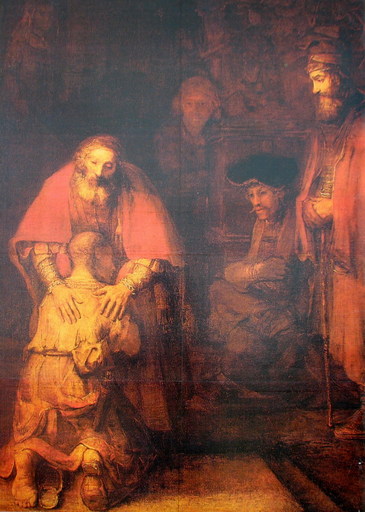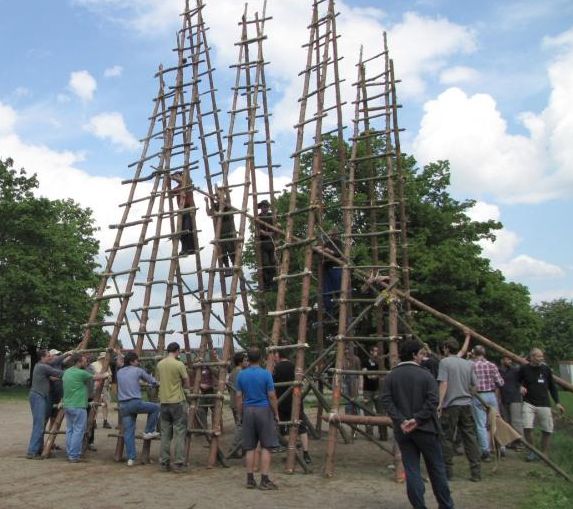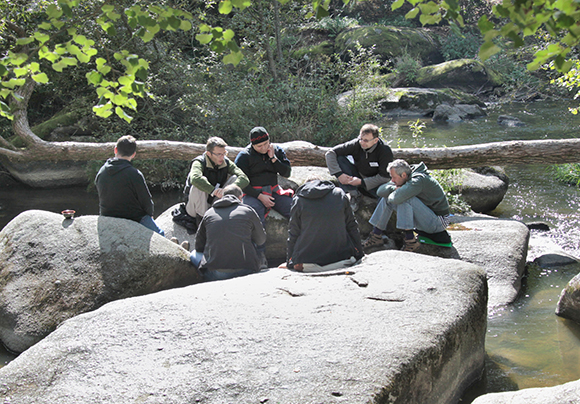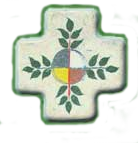
Starý muž, který se neumí smát, je trouba.
Richard Rohr
Kdo jsme?
Tento web reprezentuje hnutí Chlapi, neformální společenství mužů, kteří hledají takové způsoby duchovního prožívání, se kterými se dokážou jako muži ztotožnit a celou bytostí je žít.
Můžeš se tady setkat s muži, kteří usilují o to být lepšími a více autentickými.
Vytváříme jak reálný tak virtuální prostor pro setkávání.
Začalo to někdy před rokem 2000 hledáním mužské energie, spirituality i chlapské party a setkáváním v malých skupinách. Pokračovalo to inspirací dílem Richarda Rohra a jeho Rituálem pro přechod do zralé dospělosti a pokračuje to dodnes stovkami setkání v malých skupinách, víkendovými akcemi pro muže i pro otce a děti, rituály i celostátními setkáními pro stovky účastníků a mezinárodní spoluprací s hnutím mužů po celém světě.
Pro řadu z nás je podstatné přátelství s Bohem, pro všechny jsou oporou kamarádi, které tu nalezli.
Vítáme tě mezi námi a těšíme se na společné putování.

Pavel Hrdina a Martin Šmídek
Překlad meditace CAC ze středy 16. 8. 2023
na téma:
Prorocká cesta - láska a osvobození
| Ženský prorok církve Mystička Kateřina Sienská (1347-1380) je vzorem radikálního tradicionalismu, který otec Richard označuje za ústřední pro proroka. Joan Chittisterová popisuje Kateřinino silné svědectví: Když byla mystika zahalena tajemstvím a zahalena do soukromých extází a osobních pobožností, Kateřinina mystika ji sužovala starostmi světa a vrhala ji do samého středu života.... Když se vše ve světě kolem ní zmítalo v chaosu, a to jak v církvi, tak ve státě, Kateřina si odmítala koupit snadnou úlevu.... To, co bylo špatné, nechtěla nazývat správným, co bylo nesnesitelné, přijatelným, co bylo špatné, dobrým, co bylo utlačující, Boží vůlí.... Ne, Kateřina Sienská nazvala hrozné hrozným a bezbožné bezbožným a tímto činem vyzývá každé století po ní ještě, stále a vždy k témuž. Kateřina Sienská i dnes vlévá do lidské duše oheň a led. Konfrontuje nás s tím, co velmi potřebujeme i dnes, má-li tato církev prosperovat a tento svět přežít. Nejstarší životopis Kateřiny Sienské zaznamenává její vidění Ježíšovy výzvy, aby poučila "vzdělance" své doby: "Jak mohu být užitečná v díle záchrany duší," ptala se Krista, který ji ve vidění povolal, "vždyť jsem žena a mému pohlaví nepřísluší, abych se snažila učit muže, nebo s nimi dokonce mluvit. Kromě toho si toho, co říkáme, vůbec nevšímají." ... Byl to Ježíš z jejího vidění, který odpověděl:
Díky těmto kacířským Ježíšovým slovům [k tehdejší společnosti] se Kateřina Sienská stala duchovní matkou, veřejnou osobností, politickým prorokem, doktorkou církve. Četla duše, vedla kněze, vyjednávala mezi městskými státy, potrestala dva papeže a stala se vyslankyní státu z Vatikánu..... Vyzývá muže, aby uznali Bohem dané poslání žen potvrzené Ježíšem, zakotvené v evangeliích a potvrzené dějinami žen v církvi. Vyzývá ženy, aby odmítaly odmítnutí, požadovaly rovnost, hovořily o své spiritualitě, dávaly své Bohem dané dary, ať už jsou tyto dary žádané, nebo ne, nazývané svatými, nebo ne, legitimované, nebo ne, protože nikdo, ani církev, nemá právo popírat Boží dary nebo Boha, který působí skrze dary žen.... Osobní oběť, vhled do evangelia, křesťanský feminismus a trpělivé proroctví je odkazem Kateřiny Sienské pro jednadvacáté století. Fr. Richard Rohr, OFM přeloženo DeepL | A Female Prophet to the Church
The mystic Catherine of Siena (1347–1380) models the radical traditionalism identified by Father Richard as central to the prophet. Joan Chittister describes Catherine’s powerful witness: When mysticism was veiled in mystery and wrapped in private ecstasies and personal devotions, Catherine’s mysticism plagued her with the worries of the world and plunged her into the very center of life.… When everything in the world around her was in chaos, in both church and state, Catherine refused to buy for herself an easy reprieve…. She would not call what was wrong right, what was intolerable acceptable, what was bad good, what was oppressive God’s will…. No, Catherine of Siena called the terrible terrible and the ungodly ungodly and in that act calls every century after her yet, still, and always, to do the same. Today, still, Catherine of Siena pours fire and ice into the human soul. She confronts us with what we dearly need even now if this church is to prosper and this world is to survive. The earliest biography of Catherine of Siena records her vision of Jesus’ call to instruct the “learned men” of her time: “How can I be of any use in the work of saving souls,” she asked the Christ who called her in visions, “for I am a woman, and it is not seemly for my sex to try to teach men, or even to speak with them. Besides, they take no notice of what we say.” … It was the Jesus of her vision who responded:
Because of those heretical words of Jesus [to the society of her day], Catherine of Siena became spiritual mother, public figure, political prophet, Doctor of the Church. She read souls, guided priests, negotiated between city-states, chastised two popes, and became an emissary to the state from the Vatican…. She calls men to recognize the God-given mission of women affirmed by Jesus, enshrined in the Gospels, and confirmed by the history of women in the church. She calls women to refuse rejections, to demand equality, to speak their spirituality, to give their God-given gifts, whether these gifts are called for or not, called holy or not, legitimated or not because no one, not even the church, has the right to deny the gifts of God or the God who works through the gifts of women…. Personal sacrifice, Gospel insight, Christian feminism, and patient prophetism is the legacy of Catherine of Siena to the twenty-first century. Fr. Richard Rohr, OFM |
[1] See Raymond of Capua, Life of Catherine of Siena, part 2, chap. 1. Translation here is from Sigrid Undset, Catherine of Siena, trans. Kate Austin-Lund (New York: Sheed and Ward, 1954), 52.
Joan D. Chittister, A Passion for Life: Fragments of the Face of God with icons by Robert Lentz (Maryknoll, NY: Orbis Books, 1996), 120, 122–123, 124.
Zde se nacházejí překlady Daily Meditations, jejichž anglické originály se nacházejí na webu CAC. V den jejich vydání je zde nalezneš přeložené strojově pomocí DeepL, zpravidla do druhého dne pak projdou jazykovou úpravou někým z týmu překladatelů :-) Pokud vládneš dobrou angličtinou, přihlas se asi raději přímo u zdroje těchto úvah, tedy na webu CAC. Budeš je pak do své mailové schránky dostávat již k ranní kávě. -mš-
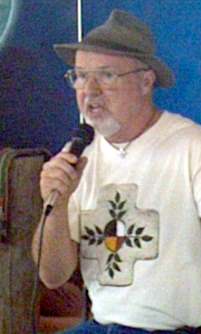 Myšlenka Richarda Rohra na Svátek Svaté Rodiny - Jak Bůh miluje Manželská setkání učí manžele, jak spolu bojovat. Drží se vzájemně za ruce, dívají se vzájemně do očí a křičí na sebe. Celou tu dobu nesmějí ruce partnera pustit. Lidé, kteří žijí v manželství, mi říkají, že tohle je nejobtížnější věc na světě. Protože když vás dotyčný opravdu zraňuje, tak se chcete odtáhnout. Nechcete se vzájemně dotýkat a dívat se …
Myšlenka Richarda Rohra na Svátek Svaté Rodiny - Jak Bůh miluje Manželská setkání učí manžele, jak spolu bojovat. Drží se vzájemně za ruce, dívají se vzájemně do očí a křičí na sebe. Celou tu dobu nesmějí ruce partnera pustit. Lidé, kteří žijí v manželství, mi říkají, že tohle je nejobtížnější věc na světě. Protože když vás dotyčný opravdu zraňuje, tak se chcete odtáhnout. Nechcete se vzájemně dotýkat a dívat se …
